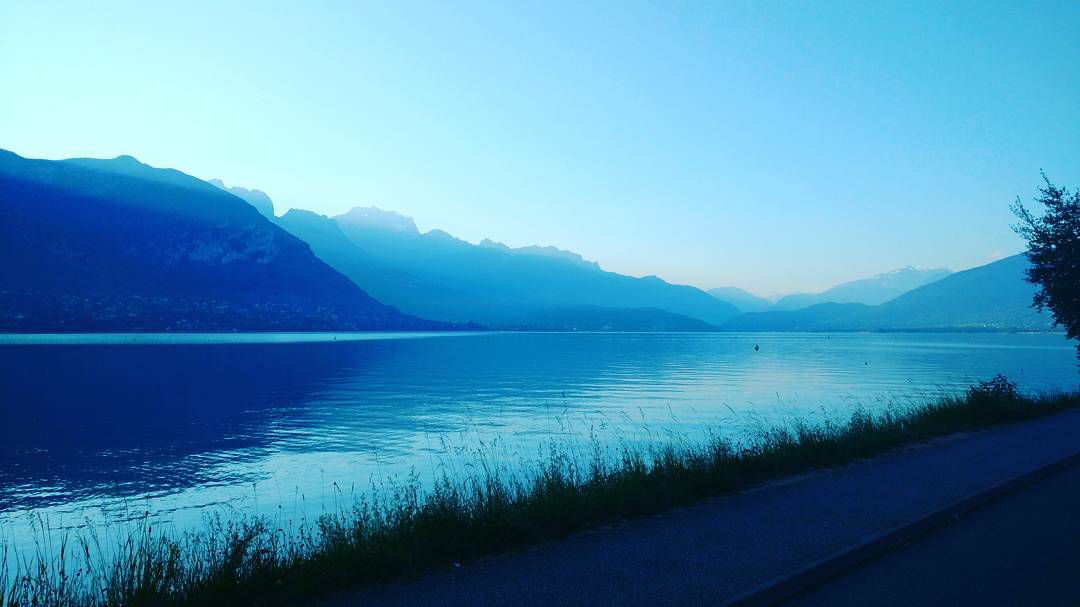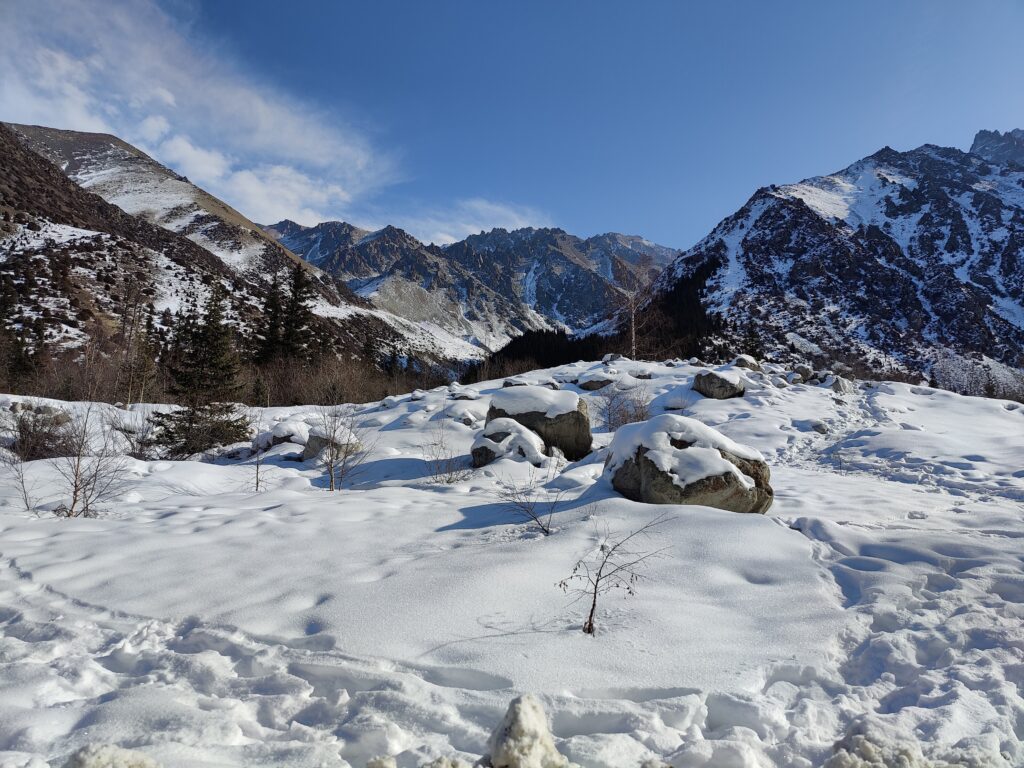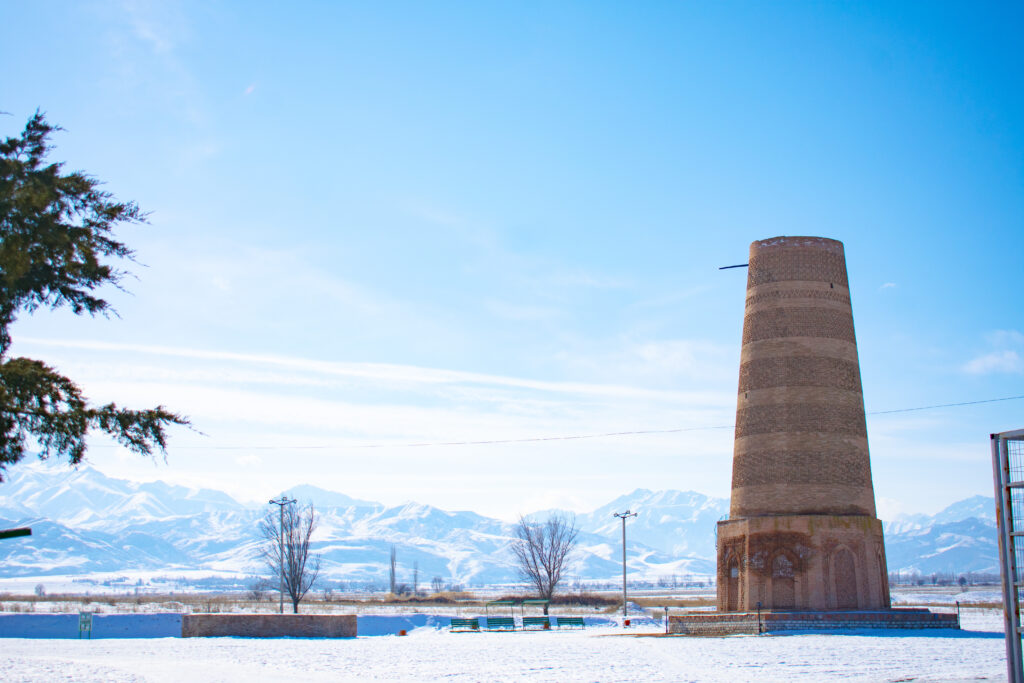While checking into the hostel in Tashkent, I spotted a Taj Mahal magnet on the fridge in the lobby. I told the receptionist with considerable pride that it is in India, where I come from. With a broad smile and equal pride, she responded that Babur, whose descendants had it constructed, hailed from the Ferghana valley in Uzbekistan. And thus began my trip to Uzbekistan, with this beautiful reminder of our shared history.
Ever since I had seen images of Registan Square in the Lonely Planet magazine, with its turquoise tiles glittering brilliantly in the sunlight, I knew I had to go there someday. After the trip around Kyrgyzstan, extending the trip for a short sojourn to Uzbekistan was a no-brainer. Before the visit, Kyrgyzstan and Uzbekistan were both distant specks on the globe to me, conveniently grouped together into the mystical, unexplored region called Central Asia. I am now embarrassed at my ignorance and naivety in thinking that they would be anything like each other.
Kyrgyzstan is almost entirely mountainous and is a bastion of nomadic traditions. It is teeming with pristine natural beauty. Uzbekistan, on the other hand, is mainly flat and has been populated by settled communities since antiquity. Kyrgyzstan draws tourists to its snow-capped mountains and alpine lakes. Uzbekistan is all about larger than life architectural marvels at the epicentre of the Silk Road. Both countries speak Turkic-derived languages. Both share a passion for Plov, their rice and meat-based national dish. After emerging from the Soviet Union, both are asserting their ethno-national identity that celebrates their unique differences.
Uzbekistan: Practical Information
Uzbekistan is well connected with Delhi through reasonably priced daily direct flights by Uzbek Air. The e-visa is super easy to obtain, requires minimal documentation, costs just $20 and takes just only 2-3 days. Very tempting, I know! The local language is Uzbek and Russian is also spoken in the cities. Tashkent is the capital though most tourist itineraries revolve around the silk road cities – Samarkand, Bukhara and Khiva.
Samarkand – Registan Square & Bibi Khanum Mosque
I had just 72 hours in Uzbekistan. I decided to spend most of them in Samarkand, the crown jewel of the Timurid Empire. After a thrifty but comfortable sleepover at the hostel in Tashkent, I took the Afrosiyob train early the next morning. For approx $10 and in just 2 hours, I was in Samarkand.
The very mention of Samarkand invokes mystique. This is what Colin Thubron, the legendary travel writer, says about Samarkand in his classic, The Lost Heart of Asia – “ ‘Samarkand’ conjures no earthly city. It is a heart-stealing sound. Other capitals of Islam – Cairo, Damascus. Istanbul – glow with an accessible, Mediterranean magnificence. But Samarkand inhabits only the edge of geography. For centuries after it slept in obscurity, it shimmered in people’s imagination”.
After dropping off my rucksack at the hostel, I headed straight out to explore.
If there’s one single image that typifies Central Asia in the popular imagination, it is that of the magnificent Registan Square in Samarkand. I could scarcely believe that I was standing right in front of it.

The square has three madrassas. Ulugh Beg Madrassa, built by Timur’s grandson Ulugh Beg in the early 15th century is the oldest in the triumvirate. It was among the best religious colleges of the period and drew luminaries as well as students from across the Islamic world. Ulugh Beg, himself an accomplished astronomer, also taught here.


The two other Madrassas, Sher Dor madrassa and Tilya Kori madrassa were constructed more than two hundred years later but follow the same architectural style. The Sher Dor madrasah is remarkable for its mosaics depicting tigers, contravening Islamic norms against depicting living creatures.

It is hard to imagine a sight more imposing than Registan Square on a sunny day with glittering mosaics. Centuries of wear and tear had left the monuments in ruins before extensive restoration in the Soviet era reinstated their former glory.
But after my time in Kyrgyzstan which is still a raw, unexplored gem, the commercialized veneer of Samarkand was unsettling. The guided tour of Registan Square was overpriced and adds little beyond the Wikipedia page. The guide kept trying to sell me more guided tours of other monuments in Samarkand and prodded me to buy souvenirs so she could make a commission. The rooms of these ancient Madrassas, which once housed students, are now souvenir stores. The handicrafts may be beautiful but pesky retailers rob the place of its charm.
After a hearty lunch of Plov, I headed to the Bibi Khanum Mosque. While Registan is the centrepiece of Samarkand, this mosque is the single largest monument in the city. Standing below its enormous portals, I felt dwarfed – as much by the audacity of human ambitions as by the scale of the structure itself. Opposite the mosque is the relatively humble tomb of Bibi Khanum, Timur’s favourite wife. Timur’s plunder of India purportedly funded the construction of this grandest of mosques.

The inside of the mosque was closed to entry. When I peeked in, I saw the crumbling interiors being hidden by the glittering exterior. It was a bittersweet feeling to glimpse this unrestored part. Restoration is obviously essential to counter natural wear and tear. To not restore monuments is to lose them irreversibly to the vagaries of nature. But with every restoration, we also lose a little of the original and somehow diminish their standing as markers of antiquity.

Samarkand – Gur-e-Amir & Siob Bazar
The next morning, I headed to Gur-e-Amir, the tomb of Timur. Timur, despised in India as a marauder, is revered in Uzbekistan and is arguably the country’s most prominent icon. His statues adorn city squares and the architecture left behind by him and those who followed in his footsteps draw tourists from across the globe. History is all about perspectives.

The architectural style of Gur-e-Amir has heavily influenced Mughal architecture in India. The interiors of the mausoleum, intricately restored, dazzle in the soft lighting. Buried beneath lie the remains of one of the most feared conquerors in history. People say that Timur’s grave is marked with an ominous warning for whoever dares to exhume his remains. Two days after a Soviet archaeologist opened his tomb in June 1941, Hiltler’s army invaded the Soviet Union. The story is apocryphal and the chain of events may be a mere coincidence. But if you are prone to believing legends, Timur continues to terrorize those who dare to defy him, centuries after his death.
These grand architectural complexes, all deftly restored, make Samarkand look gorgeous but made up. I felt that rather than ticking off more grand monuments from the checklist, I should tread off the tourist grid to see a little of the authentic local life. Quite aimlessly, I headed into an unmarked alley. And immediately I became an object of curiosity for the local residents who invariably greeted me with a warm smile and the custody “Salam Alaikum”. At a nondescript local bakery, I saw a couple of young men preparing the ubiquitous Uzbek bread, Lepeshka, in the tandoor. We tried our best to converse with the help of Google Translate. I was touched when they gifted me a big warm loaf of bread, calling it a gift from Uzbekistan to India. I walked into an unmarked eatery with only local patrons and had delicious plov.

In the evening I went to the Siab Bazar, a one-stop shop for everything from dry fruits to garments and souvenirs. This is the main market for the locals so the prices are more reasonable than at the souvenir shops in Registan, though one still needs to bargain them down further.
Tashkent – Central Asia Plov Centre & Amir Timur Square
The next morning, I caught the train back to Tashkent. Among my co-passengers on the journey was a high school student, Shaxriyor, who was well conversant in English and also translated for the other passengers. Russian was the lingua franca of the region and the older generation hardly speaks any English. But the youth see America as the land of opportunities and English as their ticket to America. The hours passed by quickly, with me answering their curious questions about India and vice versa. Their warmth and friendliness left a deep impression.
I had just a few hours in Tashkent before I had to fly out. There was time for just one meal in Tashkent, my last meal in Central Asia, so it had to be at the Central Asian Plov Centre. To call it the Mecca for Plov is an understatement. It sprawls over a huge area, the size of a mini theme park with seating for hundreds of guests and Plov cooking away in gigantic cauldrons.

I took a plate, found a spot and dug into that plate of bursting flavors. I had tasted plov elsewhere in Kyrgyzstan and Uzbekistan and always found it nice, but this place does it like no other. Hospitality comes very naturally to Uzbeks and the gentleman sharing my table offered me bread and tea.

I spent an hour people-watching, sprawled on a bench in Amur Timur Square. The winter sun was oh-so-pleasant and I quietly counted my blessings. Just as I was starting to leave, I met a young Uzbek man who spoke to me in fluent, unaccented Hindi and could easily have passed for an Indian. He had spent four years in Delhi studying Engineering and recalled his time in India with deep fondness. And the trip ended the way it had begun – with an encounter that reminded me of our shared bonds. I will remember Uzbekistan as much for the people I met as for the things that I saw.







































